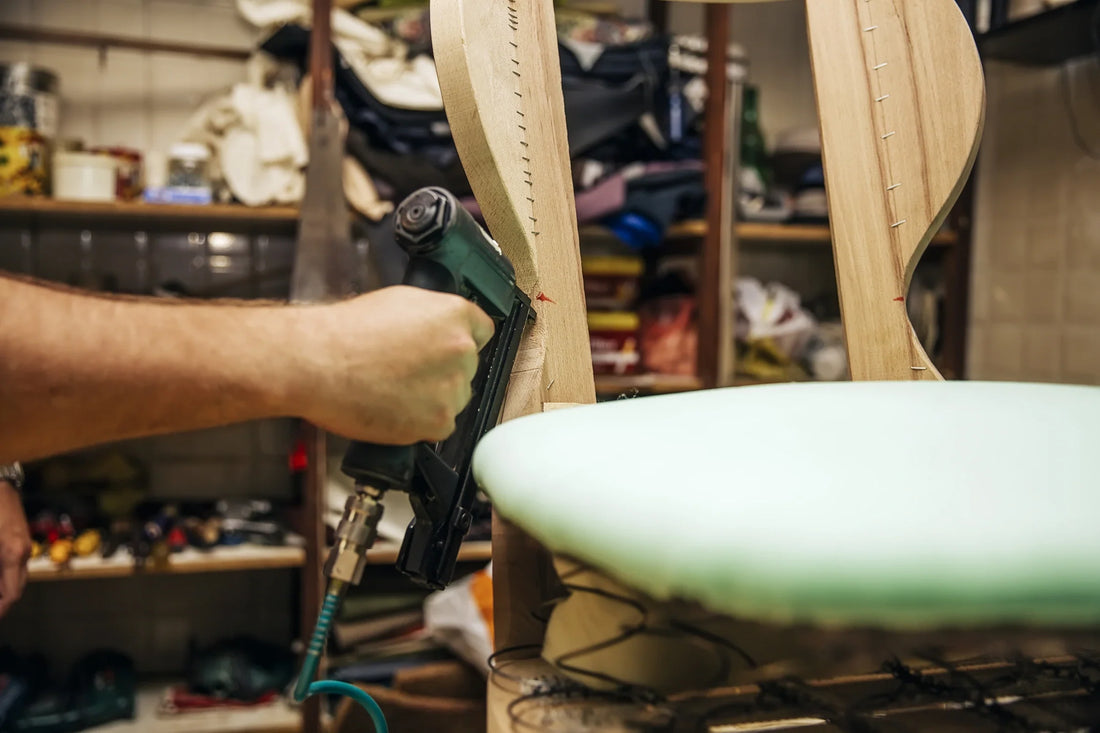Luxury does not always have to be new; it is often rediscovered. We can revive furniture with rich textures, tailored finishes, and timeless style through masterful reupholstery.
It is a refined and curated act of elegance that extends the life of meaningful pieces while honoring the legacy of skilled craftsmanship. Moreover, it offers more than breathing new life into treasured pieces; it can prolong the allure and function of our beloved pieces for generations to come.
Here, House of Chippendale will provide a simple and clear explanation of its process and benefits. Let's delve into it.
What Is Reupholstery?
Furniture upholstery is replacing the fabric, padding, and other components of a piece of furniture to update its appearance and make it more comfortable.
Reupholstery is an artisanal process that transcends mere fabric replacement. It often involves the careful repair of the piece, such as structural repairs, precision tailoring of premium materials, and specialized craftsmanship tools.
For individuals who appraise craftsmanship and sentiment, such as an old but well-made piece that needs an update or unique items that are hard to replace, upholstering is an exquisite and favorable way to breathe new life into your upholstered furniture.
The Reupholstery Process: Step by Step
Behind every beautifully reimagined piece of furniture lies a sequence of steps involving a curated process rooted in quality craftsmanship. From initial structural assessment to hand-applied upholstery techniques, each step is designed to elevate both the aesthetic and longevity of your piece.
Here are five steps in the reupholstery process:
1. Assessing the Furniture
Before the artistry of new upholstery begins, meticulously evaluate the furniture. Starting from the frame, springs, and internal padding.
During this process, the foam and batting must be examined for signs of fatigue; if they no longer offer comfort or structure, they must be upgraded.
2. Removing Old Fabric and Padding
During this step, begin by thoughtfully removing the old fabric from the seat cushion, avoiding any tearing that could compromise the piece's structure or aesthetics. Using a staple puller or fine-tipped pliers is advisable to extract each staple or nail with precision.
This meticulous approach will help protect the inner foam and padding, setting the stage for a seamless reupholstery process.
3. Repairing and Refinishing the Frame
This step involves expertly repairing the frame’s integrity and delicately restoring any worn parts, while also correcting any structural imperfections as necessary. It also consists in rejuvenating the wooden elements with refined finishes that enhance both form and function.
4. Selecting Fabrics and Materials
Thoughtfully curate the fabrics and select resilient cushioning materials. This is equally important because it will ensure each piece embodies elegance and enduring quality.
5. Applying New Upholstery

After selecting the fabrics, the next step is applying the new fabric to replace the old one and, if necessary, any decorative elements. Begin by carefully aligning the fabric with its designated placement. Gently smooth it to eliminate any creases or bubbles, then fold the material gracefully over the edges to achieve a clean, tailored finish.
Once the fabric is carefully positioned, affix it to the furniture frame. Based on how the original upholstery was installed, choose a fastening method such as staples, tacks, or screws. Remember to match the existing technique to ensure a refined and enduring result that will sustain the piece's integrity.
You may add decorative buttons, luxe trims, or bespoke embellishments to elevate your upholstery with sophisticated finishing touches. Depending on your choice, these can be sewn, stapled, or tacked into place.
Benefits of Reupholstery
Whether cost-effectiveness, positive environmental impact, or the freedom to design furniture that reflects your style, it offers a refined alternative to replacing your treasured pieces.
Here are three main benefits of reupholstery:
1. Cost-Effectiveness Compared to Buying New Furniture
Opting for reupholstery is significantly more cost-effective than purchasing new furniture, allowing you to preserve the charm and craftsmanship of your cherished pieces and extend their life with bespoke elegance.
2. Environmental Impact
You make an eco-conscious statement. Unlike mass-produced sofas often laden with petrochemicals and flame-retardants, reupholstered pieces offer superior craftsmanship and a healthier indoor environment. A luxurious choice that minimizes its environmental footprint.
3. Customization Opportunities
Reupholstering furniture offers an unmatched level of customization, allowing you to curate each piece to your exact taste. From hand-selected fabrics to exquisite patterns and tailored finishes.
This artisanal process invites you to create furnishings that seamlessly complement your interior vision, far beyond what mass-produced furniture can offer.
Also read: How to Clean Couch Upholstery: DIY Care Tips.
Reupholstery is the refined art of extending the life of meaningful pieces while honoring the legacy of skilled craftsmanship. Individuals who honor heritage and refinement by reviving a cherished piece through bespoke upholstery are the ultimate expression of style and sentiment.
Suppose you honor timeless beauty and seek upholstery. In that case, we invite you to the House of Chippendale's reupholstery, where you will experience the transformation of classic furniture into elegant, refined, and hand-crafted masterpieces with unmatched care and expertise. Need further assistance? Book a consultation with us today.





